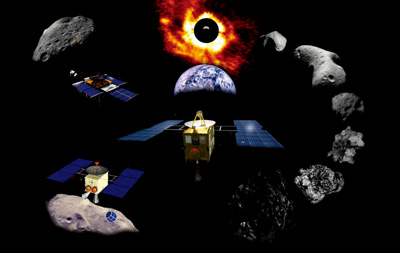TOP > Report & Column > The Forefront of Space Science > 2004 > The Role of Solar-System Exploration in the Space Science Vision
![]()

One year has passed since the HAYABUSA spacecraft set off on its round trip to the asteroid Itokawa. Just as steam locomotives were propelled by stoking coal in the fire, HAYABUSA is being driven continuously by its electrical-propulsion engine, a very different method from interplanetary probes in the past that were governed by Keplarian orbital dynamics. The reason why I, an experimental scientist, find challenges in my duty as the spacecraft's "driver" (one of its operational supervisors) is that daily operation itself is just a technological experiment necessary for the further development subsequent solar-system explorations following the HAYABUSA mission. A number of new technologies demonstrated by HAYABUSA, including electrical propulsion and asteroid-surface sampling, will likely be introduced to next-generation planetary probes. What will main science targets be for solar-system exploration in the 2010's? This question is directly linked to the space science "vision" pledged by JAXA. As I reach the age of 36 (surprisingly!), the same age as E. Krantz when he served as lead flight director of Apollo 13, this is a question that my generation should take an initiative to tackle. Formation of planetary science and HAYABUSA's mission Before answering the above question, let us consider why scientists at present time are devoted to solar-system exploration. It is said that modern "scientists" first appeared as specialists in a narrow "subject" in Europe in the mid-19th century. Prof. Shinichiro Tomonaga defined physics, which constitutes the core of modern science, as the "quest for laws existing behind every phenomena arising in nature around us, mainly for inanimate beings, based on the observation of facts". Meanwhile, Schrodinger recognized that, "we inherit from our ancestors the passion to seek for unified knowledge encompassing everything about us." He then shifted the 20th century from the "century of physics," which tried to understand by breaking down into factors, to the "century of life sciences," which describes nature by integrating interdisciplinary elements. In this context, "planetary science," which is originally based on classical physics, has been evolved into an interdisciplinary field by integrating various research methodologies, such as astronomical observation, meteoric analysis, simulation experiments and theoretical model calculations. In the late 20th century, we obtained another arm, "in-situ exploration" by sending spacecraft, which brings us to the present form of planetary science. Solar system exploration is not meant to be an omnipotent method that solves all the mysteries of a target body in a single mission. Rather, it is an activity that contributes to draw a comprehensive picture of our solar system, by collecting local information of planets and other target bodies, which are complementary to other methods. Take the example of HAYABUSA. Among over 100,000s of asteroids detected by telescopic observation, more than 2,000 have been classified by reflectance spectrum types. The data, however, are low-spatial resolution information of surface materials of each asteroid and, naturally, their patterns largely depend on local terrain, shape and size of regolith particles, space weather effects, etc. Meanwhile, tens of thousands of meteorites, and cosmic dust, which are fragments of minor bodies, have been collected on the Earth and compiled into catalogs. Since they had reacted with the terrestrial environment after entering the atmosphere, however, we cannot identify the parent body of each sample, except for the Moon, Mars and Vesta. By just looking at a stone found on a riverbank, it is difficult to estimate the upstream conditions of where the stone originates - such as stratum location, history of accumulation, and formation processes. This is also true for meteoric studies. By just investigating meteorites with their origins unknown, we cannot devise spatial distribution of primordial materials in the solar system. First, meteorites and cosmic dust collected on the Earth do not correctly reflect features of the entire solar system without bias. On the contrary, after observing globally the S-type asteroid Itokawa with its on-board camera and spectrometer, HAYABUSA plans to return to Earth with samples of Itokawa that have information on its original state. We will then compare them directly with a specific meteorite group (i.e., ordinary chondrites). After these processes, the two databases of asteroidal spectral types and meteorite/cosmic dust classes will be bridged so that researchers can re-work these databases with the ground truth. This is one of the great contributions that can only be made by the sample-return mission (Fig. 1). 
|
|||||||





